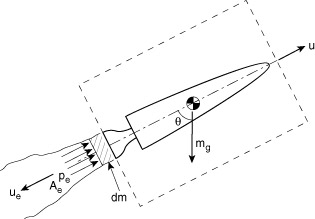V. Rocket Performance
A. Thrust and Specific Impulse for Rockets
During the Fall semester thermodynamics lectures we used the steady flow energy equation to relate the exhaust velocity of a rocket motor to the conditions in the combustion chamber and the exit pressure

Figure 5.1 Schematic of rocket nozzle and combustion chamber
The steady flow energy equation
![]()
then with no heat transfer or shaft work
![]()
which can be written as
![]()
and manipulated to obtain


Then considering the relationship we derived for thrust
![]() and assuming pe = po =
0
and assuming pe = po =
0
then ![]()
and ![]()
so ![]()
Thus the specific impulse can be directly related to the exhaust velocity leaving the rocket
![]()
B. The Rocket Equation
We can now look at the role of specific impulse in setting the performance of a rocket. A large fraction (typically 90%) of the mass of a rocket is propellant, thus it is important to consider the change in mass of the vehicle as it accelerates.
Q6 (PDF)

Figure 5.2 Schematic for application of the momentum theorem.
There are several ways to do this through applying conservation of momentum. Here we will apply the momentum theorem differentially by considering a small mass, dm, expelled from the rocket during time dt.
The initial momentum of the mass in the control volume (the vehicle) is
mvu
The final momentum of mass in the control volume (the vehicle and the mass expelled, dm) is
(mv - dm)(u + du) + dm(u - ue)
= mvu + mv du - udm – dudm +udm -uedm
The change in momentum during the interval dt is
= momentumfinal – momentuminitial
= mv du - uedm (since dudm is a higher order term)
Now consider the forces acting on the system which is composed of the masses m (the rocket), and dm (the small amount of propellant expelled from the rocket during time dt):
![]()
Applying conservation of momentum, the resulting impulse, SFdt, must balance the change in momentum of the system.
![]()
then since ![]() where
where ![]() = propellant
mass flow rate
= propellant
mass flow rate
we have
![]()
or for pe = po
![]() The Rocket Equation
The Rocket Equation
The above can be integrated as a function of time to determine the velocity of the rocket.
If we set ue = constant, and assume that at t=0, u=0, and neglect drag, and set q = 0, then we arrive at
![]()
which can be integrated to give
 where
where![]() is
the initial mass of the rocket
is
the initial mass of the rocket
or

We can view this equation as being similar to the Breguet Range Equation for aircraft. It presents the overall dependence of the principal performance parameter for a rocket (velocity, u), on the efficiency of the propulsion system (Isp), and the structural design (ratio of total mass to structural mass – since the initial mass is the fuel mass plus the structural mass and the final mass. is only the structural mass).
Assuming the rate of fuel consumption is constant, the mass of the rocket varies over time as
![]()
where tb is the time at which all of the propellant is used. This expression can be substituted into the equation for velocity and then integrated to find the height at the end of burnout:

which for a single stage sounding rocket with no drag and constant gravity yields

the final height of the rocket can then be determined by equating the kinetic energy of the vehicle at burnout with its change in potential energy between that point and the maximum height. This is left as an exercise for the reader.
Q19 (PDF)
There is a great site on the web that describes performance analysis for multistage model rockets - http://my.execpc.com/~culp/rockets/multistg.html |

Figure 5.3 The Saturn V rocket stood 365 feet tall and had 5 stages. It produced over 7.5 million pounds of thrust at liftoff (NASA, 1969).
| << Previous | Unified Propulsion | Next >> |